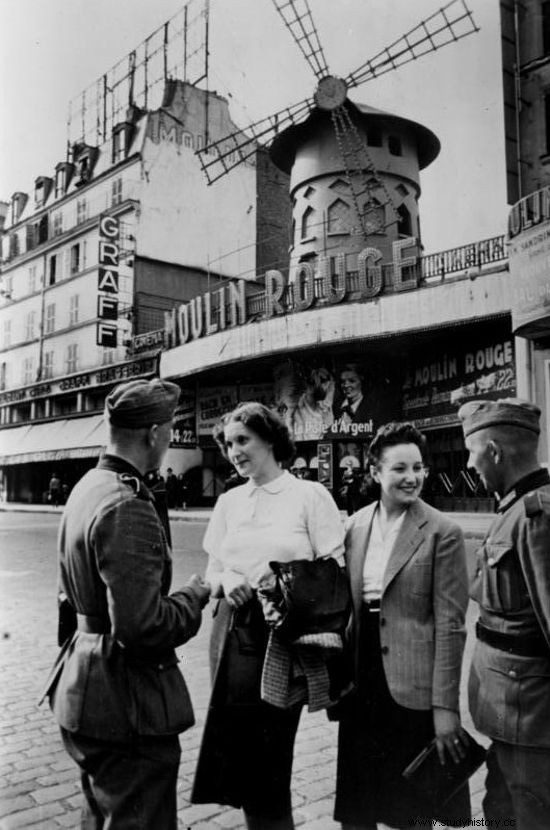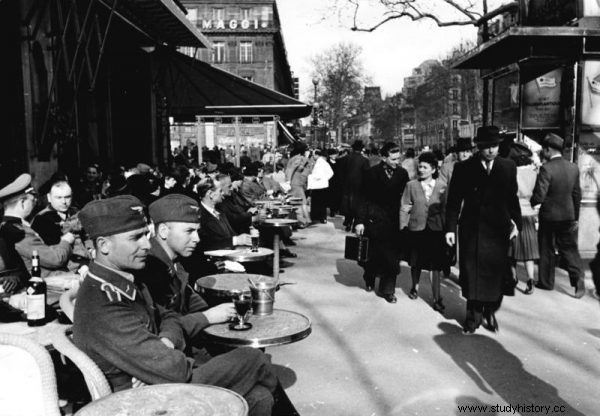French historians would like to convince the whole world that Parisians suffered unparalleled sacrifices during World War II. They were starved, robbed, and stripped of human dignity. Is this the only side of the coin? And what could the Poles who spent the occupation in Warsaw say about it?
My heart is French, but my butt - international - Arletty, an actress sentenced to 18 months in prison after the war for maintaining intimate relations with a Nazi officer, was to say. These words, which are impossible to imagine in post-war Poland, reflect the atmosphere of occupied Paris quite well.
Triumph of degenerates
June 22, 1940, a railway car in the Compiègne forest. General Charles Huntziger signs the ceasefire. At this point it becomes clear that - for the time being - Hitler is invincible . France is divided into two parts:the "free" one, led by the Vichy puppet government, and the one occupied by the Germans. 
Paris is salt in Hitler's eye. The domination of degenerate French culture over pure German thought was to end soon. Therefore, one had to fight not only with Jewish influences in art, but also with promiscuous French fashion, for which even the Führer's mistress, Ewa Braun, had a great weakness. However, at least in this respect, the French did not allow themselves to be defeated by the Germans. As Maurice Chevalier said: Paris must become Paris for the soldiers on leave to experience a bit of Parisian charm .
City of Sin
Conquered without a fight on June 14, the French capital fell into the hands of the Nazis. After recovering from the first shock, Parisians adapted relatively quickly to the presence of enemy troops. This "degenerate city" knew what it could offer to soldiers coming from prudish Nazi Germany - nudity!

The Germans and the French under the Moulin Rogue (photo:Heinz Boessig, public domain via Bundesarchiv).
The German assault on nightclubs, cabarets and brothels has begun . In July, over a hundred theaters were already operating, and in August, the Paris Opera was reopened. There is probably no better summary of this situation than the words of Professor Jerzy Eisler, who sneeredly said: the German officer, arriving in Paris, had only one fight ahead - for tables in a cafe.
From the Polish perspective, talking about the occupation of Paris seems downright inappropriate. Pictures from the streets of Paris in 1940 do not resemble those known from then Warsaw or other Polish cities. This is evidenced by the collection of almost seven thousand photographs commissioned by the Nazis and made by André Zucca.
A recent exhibition, which shows only two hundred and seventy of these photos, caused a real storm over the Seine. Full pubs, laughing ladies in hats, couples in love . It is certain that the propaganda images were intended to show the occupation in pink colors. Malicious people, however, claim that the author did not have to make any special effort ..
War luxuries
The legendary Paris Ritz hotel was also synonymous with luxury during the occupation. One of its floors was entirely reserved for the first brawler of the Third Reich - Herman Göring. The shelters in the hotel basement were to be lined with animal skins and equipped with silk Hermes sleeping bags. Legend has it that when Coco Chanel went down to the bunker, a servant carried a gas mask on a silk pillow for her .
Despite the curfew (from 23:00), Paris nightlife flourished. Edith Piaf seduced the Germans from the stage, the best places printed their menus in German. The Nazis were generally considered to be favorable to the French.

The legendary Edith Piaf during the occupation graced the evenings in the legendary Paris brothels (photo:Eric Koch, National Archives in The Hague, license CC BY-SA 3.0 nl)
No wonder - after all, Paris was an occupation paradise on earth for Wehrmacht soldiers . Each French was also aware of the significant benefits of maintaining good relations with the occupant. From turning a blind eye to illegal champagne shipments, through additional food rations, to saving lives.
Self-censorship
Perhaps one of the most astonishing data on the occupation in Paris may be the number of books published in 1940–1944. Well, nearly 33,000 works have been published legally. It happened without the interference of the Germans - French publishers signed an agreement under which they themselves were responsible for the content of the printed books. In this way, they created a specific index of forbidden books trying to anticipate the wishes and preferences of the Nazis.

Paris in 1941 (photo:Langhaus, public domain via Bundesarchiv).
It is possible that for France the most difficult settlement of the war remains a reliable assessment of the attitudes of intellectuals . Only the most staunch supporters of the Nazis received an unequivocal evaluation of their war behavior. Most have avoided the consequences of collaboration. Also known for his love affair with communism, Sartre had his ears behind him. His words are paradoxical: We have never felt more free than under the German occupation .
Vel'd'Hiv Stadium
July 1942. More than thirteen thousand Jewish women, men and children are locked up at the Vel'd'Hiv Stadium. Most of them will end up in camps such as the notorious Drancy. However, this is not just another Nazi action - it is an action planned and fully carried out by French officers .
The conditions in the stadium are dramatic - no sanitation, water and food. Flats and properties left behind by Jews immediately fall into the hands of Parisians . Compensation processes have been taking place in Paris to this day. Two years later, the same stadium is used as an internment site for nearly three thousand people accused of collaborating with the Germans. And like the Jews, they end up in the Drancy camp.
A city without a look
La ville sans regard - city without a look. This is how German soldiers called Paris. The French preferred to pretend they could not see the occupiers to keep the appearance of a normal life. However, it has to be honestly admitted that glitter and midnight sun were not common to the majority of society. Paris, like other cities of war, struggled with hunger, cold and poverty .

Vichy Pierre Laval head of government and Carl Oberg, head of the SS and police in occupied France. These two "gentlemen" discussed, inter alia, extermination of the Jews in northern France (photo:public domain).
And here it was not without drastic rationing of food and fuel. Thousands of children were sent from the capital to the villages and small towns in the hope that this would increase their chances of survival. As a result of the war, masses of women also remained in Paris, who had to fight to survive without the help of their husbands, fathers and brothers. Their place was gradually taken by German soldiers, for which after the war they were cruelly avenged on "bed collaborators".
Difficult questions, no answer
To some extent, the process of settling accounts with history continues in France to this day. According to Henry Rousso, about forty thousand people were imprisoned after the war for collaborating with the Nazis. Another fifty thousand were sentenced to infamy and approximately seven thousand to the death penalty, of which only seven hundred were eventually carried out.
Amnesty in 1951 and 1953 meant that in 1960 there were only nine collaborators in French prisons! This closed French discussions on the occupation for many years. The French prefer to focus on the activities of the resistance movement today rather than recall the infamous episodes of World War II.
Inspiration:
- Charles Balfour, Parisian architect , Znak Horyzont, Krakow 2016
Bibliography:
- Antony Beevor, Artemis Cooper, Paris Liberated , Znak, Kraków 2015.
- Tilar J. Mazzeo, Hotel Ritz. Life, Death and Betrayal in Paris , Znak, Kraków 2015.
- Alan Riding, And the fun was in full swing. Cultural life in occupied Paris , Świat Książki, Warsaw 2012.
